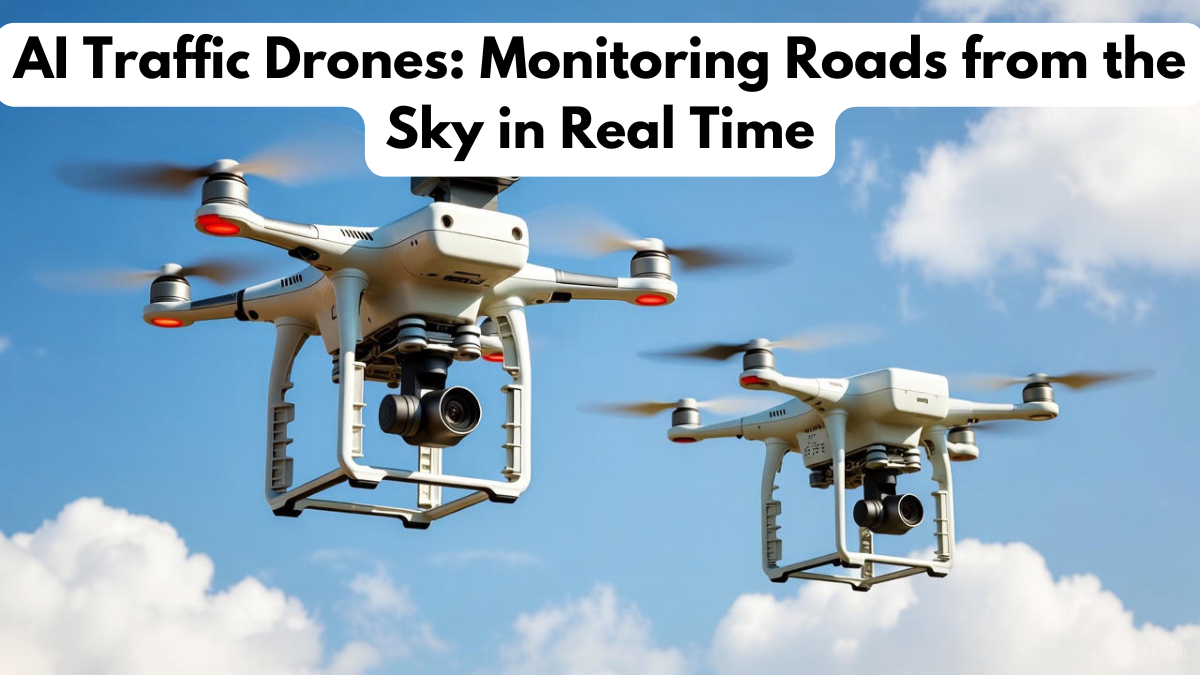The evolution of urban mobility is reaching new heights with the introduction of AI traffic drones, an advanced aerial technology designed to monitor traffic, enhance safety, and manage congestion from above. These intelligent drones provide real-time data and automated insights, allowing cities to analyze road conditions with unprecedented accuracy. Powered by cutting-edge smart surveillance systems, AI-driven drones are becoming essential tools for traffic authorities, emergency responders, and smart city planners who aim to create safer and more efficient transportation networks.

How AI Traffic Drones Are Transforming Urban Mobility
For decades, traffic management relied heavily on ground-based cameras, traffic lights, and manual monitoring. However, these traditional systems have limitations when it comes to visibility, coverage, and response times. AI traffic drones overcome these challenges by offering an aerial perspective, allowing officials to see road networks from a bird’s-eye view. This technology enables rapid detection of accidents, road blockages, bottlenecks, and rule violations.
Because they integrate smart surveillance features, these drones can automatically identify abnormal driving behavior, such as speeding, abrupt lane changes, or illegal parking. They can also relay crucial information to police units and emergency teams instantly. By providing real-time situational awareness, AI traffic drones support faster decision-making and help reduce traffic-related delays and risks.
Technology Behind AI Traffic Monitoring
The success of AI traffic drones depends on a combination of drone engineering, machine learning, aerial sensing, and intelligent data processing. Using high-resolution cameras and advanced analytics, drones equipped with smart surveillance systems can interpret patterns, track vehicles, and predict potential congestion points before they escalate.
Below is a table highlighting the technologies used in AI traffic drones:
| Technology | Function | Benefit |
|---|---|---|
| High-Resolution Aerial Cameras | Capture detailed road footage | Enhances accuracy of traffic monitoring |
| Smart Surveillance AI | Detects traffic violations and patterns | Improves safety and real-time decision-making |
| GPS and Geo-Mapping | Provides precise location data | Supports efficient traffic routing |
| Machine Learning Models | Analyze road conditions over time | Predicts congestion and improves planning |
| Live Data Transmission | Sends real-time updates to control centers | Enables immediate response to incidents |
With these combined systems, AI traffic drones can observe broad city landscapes and focus on specific vehicles when necessary. As smart surveillance continues to evolve, drone-based monitoring will become even more precise and autonomous.
Benefits of AI Traffic Drones for Cities
The advantages of AI traffic drones extend far beyond basic monitoring. They offer a scalable, adaptable, and cost-effective alternative to traditional ground surveillance systems. Supported by sophisticated smart surveillance tools, drones enhance the overall quality and safety of urban transportation.
Key benefits include:
- Rapid detection of accidents and traffic jams
- Real-time monitoring across large areas
- Reduced need for expensive ground infrastructure
- Faster emergency response times
- Improved enforcement of traffic rules
- Enhanced data collection for city planning
- Increased safety through automated alerts powered by smart surveillance
These benefits contribute to smarter, safer, and more efficient cities. Traffic authorities can easily identify recurring issues, optimize signal timings, and enforce regulations more effectively.
Future of Drone-Based Traffic Surveillance
As cities continue expanding, the need for advanced monitoring becomes even more critical. The future of AI traffic drones looks incredibly promising, with innovations focusing on autonomy, energy efficiency, and deeper integration with smart city networks. In the coming years, drones will be able to operate independently for longer durations, charge at automated docking stations, and coordinate through centralized AI platforms.
With next-generation smart surveillance capabilities, drones will soon predict traffic congestion before it happens, assist in managing public events, and even guide autonomous vehicles. They may also play key roles in air mobility systems, monitoring drone-based deliveries and flying taxis. The combination of expanded drone fleets and AI-driven analytics will redefine how cities move and operate.
Conclusion
The rise of AI traffic drones signals a major transformation in urban traffic management. By combining aerial monitoring with intelligent smart surveillance, cities are gaining powerful tools to enhance safety, reduce congestion, and improve road efficiency. As technology continues to advance, AI-powered drones will become an integral part of smart city infrastructure, ensuring that urban mobility is safer, smoother, and more intelligent than ever before.
FAQs
What are AI traffic drones?
AI traffic drones are aerial monitoring devices that use artificial intelligence and smart surveillance systems to manage and analyze road traffic.
How do AI traffic drones reduce congestion?
They detect accidents, identify bottlenecks, and provide real-time data that helps authorities optimize traffic flow.
Are AI traffic drones safe for public use?
Yes, AI traffic drones follow strict flight protocols and rely on advanced smart surveillance systems to operate safely.
Can drones identify traffic violations?
Absolutely. With smart surveillance, drones can detect speeding, illegal parking, and other violations in real time.
Will AI traffic drones replace ground cameras?
They may complement but not fully replace ground systems, as AI traffic drones offer broader coverage and intelligent mobility.
Click here to learn more